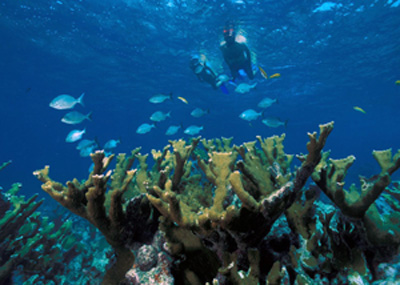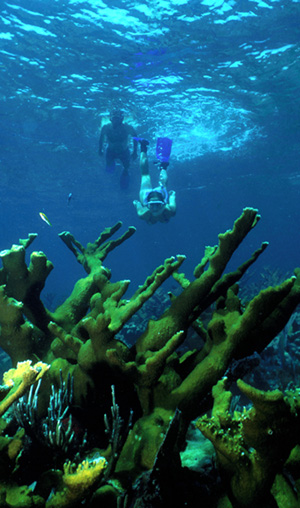
Reef is focus of bay preservationists
HOMESTEAD, Fla.— “We have the third largest coral reef in the world,” said Richard Walkley, who has been a proud volunteer at Biscayne National Park for over 10 years. “The first largest being Australia, the second largest being Belize, and the third being us.”
The fortress of coral reef that exists at Biscayne National Park is very close to shore and in close proximity to the urban community of Miami. While this has benefited the park by attracting tourism, the coral reef is in a very vulnerable location for its foreseeable destruction.
Jorge Acevedo, a National Park Service ranger at Biscayne National Park here, believes it is the responsibility of nature enthusiasts to preserve this rare ecosystem for future generations. Many people agree that preservation is important, but perhaps they do not realize the gravity of the situation.
 |
Elkhorn coral is among the different forms of coral found on the reefs of Biscayne National Park (Photos courtesy of the National Park Service). |
The reason that these coral reefs are so rare in the first place is because there are specific conditions necessary for them to survive. Long ago, biologists guessed that corals were regular plants. Through extensive research, they discovered that coral is actually a colony made up of thousands of miniscule “animals” known as polyps.
Billions of these polyps are required to build a coral reef. Polyps extract the minerals they need, like calcium, from the sea they are immersed in. Nutrients allow coral to form a skeleton around the polyps. Forming in close proximity, side-by-side and on top of one another, these corals build the structure for a stunning reef.
Certain conditions are required for reef building.
The water temperature must be no lower than 68 degrees and no deeper than 200 ft. Truly clean water is a rarity today and it is also necessary for polyps to thrive. Because these structures are living, they also need to receive adequate lighting.
The problems facing Biscayne’s coral reef, are the same problems that exist in the West Atlantic and Caribbean. For example, global warming and hurricanes are Mother Nature’s way of shaking up these areas. Although we cannot directly control these events, we can make the effort to study their effects on resources.
“I did my dissertation within Biscayne National Park studying hurricane’s effects on coral reef populations,” said Diego Lirman, a biologist at the Rosenstiel School of Marine and Atmospheric Science of the University of Miami.
Tropical storms and hurricanes create large waves, which in turn can smash coral into oblivion. Heavy rainfall, which brings an excess of freshwater into Biscayne Bay, devours coral by carrying destructive land pollutants, like fertilizers and other chemicals.
Global warming and its consequences has been a hot-button issue in the realm of both science and politics. The power that global warming has on coral reefs cannot be ignored.
Global warming causes water temperatures to rise and leads to reef “bleaching.”
This bleaching causes the algae that live inside polyps to die, inevitably starving the coral. Global warming is so intense that the higher temperatures alone may destroy some species.
Many people have posed the question, “What does global warming have to do with me?” The problems caused by humans, such as overfishing, water pollution and chemical runoff put the coral under additional stress during times of warming. It simply gives the coral less of a chance at surviving harsh conditions.
“The relative contributions of the various problems are not well understood so it is difficult to say what the most severe problems are,” said Amanda Bourque, a biologist at Biscayne National Park. “Due to the large scale of these problems, realistic solutions are not immediately apparent.”
The reefs at Biscayne were discovered in 1877. Today, these reefs are easily accessible, the park being just a short car ride for tourists or locals. However, this convenience is one of the major contributors to the decay of corals reefs.
Careless boaters often run aground, causing irreparable damage to coral. If the old expression “Brown, brown, run aground, blue, blue, sail on through,” sounds familiar, then you may be aware of some of the precautions about boating near reefs.
Having tide and navigational charts of the waters you are exploring is an easy way to avoid damage. When anchoring at Biscayne Bay or any other body of water, one should always be careful to anchor into sand and not the reef. Anchor and chains from boats have been known to tear up seagrass beds and run into the fragile coral.
 Steering clear of very shallow areas is always a smart idea. “Biscayne Bay is a very shallow body of water,” said Biscayne National Park Ranger Jorge Acevedo. “One of the most negative impacts we have on our resources is people running aground,” he added.
Steering clear of very shallow areas is always a smart idea. “Biscayne Bay is a very shallow body of water,” said Biscayne National Park Ranger Jorge Acevedo. “One of the most negative impacts we have on our resources is people running aground,” he added.
Personal watercraft and airboats are not permitted inside Biscayne National Park and most other parks. This is because it is not as easy for the park to monitor these activities and they often cause damage to not only the reef, but wildlife as well.
Divers and snorkelers are often unaware of their impact on Biscayne’s reefs. The park stresses the fact that rough sea conditions, with poor visibility and strong wind and waves, can increase the likelihood of damage to the reef. Also, the fins that divers wear are necessary for them, but very risky to coral.
The slightest touch of a fin to a group of polyps can destroy many years worth of coral growth.
One of the best ways to avoid this type of incident is to wear the lightest gear possible.
Although it is hard to pinpoint specific solutions to problems facing the reefs, scientists and politicians do have plans in the works.
“A lot of effort goes into learning more about coral reefs,” said Bourque. “Some efforts to protect the reefs include addressing fisheries’ regulations, establishing marine protected areas, and public outreach.”
Since 1990, scientists have been gathering research data from six locations in Biscayne Bay. They are measuring specific conductivity, dissolved oxygen, acidity, temperature, turbidity and tide height. They hope that with these statistics, we can better form policy and water resource management.
Grassroots groups, like Key-West Based Reef Relief, have clean water campaigns. In order to keep the reef alive, we are in desperate need of improved sewage and stormwater treatment and nutrient removal.
In order to manage both human activities (like fishing), and coral activity, government has implemented Marine Protected Areas, or MPAs. These MPAs provide guidelines and special zones in which activities are allowed.
By 2010, the U.S. government plans to protect 20 percent of all coral reefs as marine reserves.
The MPAs provide several types of monitoring, like physical, biological and socioeconomic parameters. Physical parameters measure the physical environment surrounding reefs to help predict how environment might change. Early detection of new problems is important, because coral reefs are going to be extinct within this century if something severe is not done.
Biological parameters record the trends observed by organisms that call Biscayne’s reef their home. Common parameters include composition and size, other characteristics of coral and the presence of newly settled corals.
Socioeconomic monitoring keeps track of how people interact with reefs. This is possibly the most important type of monitoring. It assesses social, cultural and economic conditions in nearby communities.
Nonprofit grassroots groups want to assess the future impact that Florida residents have on coral decline in Biscayne Bay. It is not uncommon for these groups to send out surveys or questionnaires via mail. Naturally, not everyone will respond, but it is just one of the many ways they are trying to establish environmental awareness among Floridians.
It would be an understatement to say that overfishing is a problem. Thousands of species live in Biscayne National Park’s coral reef. One fourth of all marine life in the U.S. and 40 percent of the world’s fish species reside here.
While there are many blatant examples of problems caused by overfishing, many fail to acknowledge biodiversity and ecological balance. One specific example would be the popularity of catching Grouper, a common fish for consumption.
When fishers monopolize Grouper, the species that Grouper tends to feed on, Damselfish, may overpopulate. These fish are known to create pockets in the coral. One thing leads to another, and before you know it algae has worked its way over a reef and eventually smothers huge portions of it.
By overfishing, people are indirectly contributing to the destruction of Biscayne’s coral reef. Non-profit organizations that fight for coral preservation hope that the establishment of MPAs will reduce overfishing and in turn reduce coral decay. Some MPAs exclude fishing, collecting or mining of any kind. They are sometimes referred to as “no-take zones.”
“Several projects are focused on coral reefs in Biscayne,” said Bourque. “These include long term monitoring, vessel grounding restoration, and fishery and water quality monitoring.”
The federal government made a conscious effort to get involved with the fight against reef destruction. The Coral Reef Task Force, a national action plan for coral reef conservation was created in 2000. This is the first plan specifically designed to address ways to reverse human’s negative impact on the coral reef ecosystem.
Certain corals in Biscayne Bay, such as Elkhorn and Staghorn coral, have been recognized as threatened under the Endangered Species Act. The National Oceanic and Atmospheric Association was responsible for this step forward for awareness. This is the first time a species of coral was recognized as truly “endangered.” Also, the Endangered Species Act of 1973 has given additional protection to more than 500 endangered species.
Currently and in the future, politics will play a key role in the road to recovery for coral in Biscayne National Park and all other reefs. Politics and environmental science have not always meshed well due to issues that have been seen as more important in government agenda.
It is imperative that people ask what politicians can do for Biscayne’s coral reef. Elections like those for the U.S. Senate and the House of Representatives can be closely related to what environmental changes are made.
Humans have such a strong impact on nature. It is our responsibility to help preserve coral reefs. After all, we do not own this earth. We are merely living on it.
British physician Thomas Fuller once uttered “We never know the worth of water, till the well is dry.”
Only now that the coral reefs at Biscayne park and those around the world are facing their imminent demise are people beginning to realize that actions must be taken.

Comments are Closed